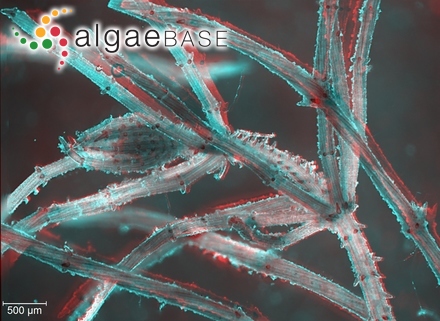Chara aspera Willdenow 1809

Current name:
Chara aspera Willdenow
Red-cyan anaglyph. Houghton Regis Chalk Pit (Marl Lakes) SSSI, Bedfordshire, UK. - 15 May 2017. Chris Carter(chris.carter'at'6cvw.freeuk.com
Publication Details
Chara aspera Willdenow 1809: 298
Published in: Willdenow, C.L. (1809). Fünf neue Pflanzen Deutschlands. Magazin für die Neuesten Entdeckungen in der Gesammten Naturkunde 3: 296-299.
Type Species
The type species (lectotype) of the genus Chara is Chara vulgaris Linnaeus.
Status of Name
This name is of an entity that is currently accepted taxonomically.
Type Information
Type locality: "Wächst in einem etwas salzigen See an den Ufern der Ostsee bei Warnemünde." [Growing in a salt lake on the shores of the Baltic Sea near Warnemünde][Warnemünd, Mecklenburg, Germany}; (Willdenow 1809: 299) Lectotype: B; W17100-010 (Wood & Imahori 1965: 203)
Origin of Species Name
Adjective A (Latin), rough, uneven, harsh, rugged.
General Environment
This is a freshwatermarine species.
Description
The plants are 5-30 cm long in brackish water (f. marinae Wahlstedt) and 5-10 cm long in freshwater (f. stagnalis Wahlstedt). The freshwater form is commonly encrusted and grey in colour, while the brackish water form is only slightly encrusted or unencrusted and green. The branchlets are 8-9, each with 6-8 segments. The stem cortex is triplostichous, isostichous to tylacanthous. The spine cells are solitary, acute, often as long as the stem diameter. The density of the spine cells varies much, from dense to scattered. The variations in the spine-cell structure have given rise to description of many varieties and forms (Migula 1897, Corillion 1957). The stipulodes are developed in both rows, the cells in the upper row are longer than in the lower row. The bract cells are 5. The bracteoles are longer than the oogonium.
The plant is dioecious. The gametangia are at the 2-3 lowest branchlet nodes. The oogonium is solitary and up to 800 µm long. The oospores are black and up to 700 µm long. The antheridia are red and up to 600 µm in diameter. Spherical, whitish bulbils up to 1 mm in diameter are common.
Chara aspera f. subinermis Kützing
The plants are up to 12-13 cm long. The spine cells are short, nearly papillous. The bract-cells are also short. This form has been found along the coasts of the Baltic Sea. In sterile state is this form difficult to separate from Chara globularis.
Habitat
Chara aspera is found in both freshwater and brackish water. In brackish water the species tolerate salinity between 3 and 15 PSU. It is common in the Baltic Sea, on exposed and sheltered places. It grows down to 4-5 m dept, on mud or sand bottom.
In freshwater C. aspera is found in calcareous waters, Chara-lakes, humic Chara-lakes and Potamogeton-lakes.
Chara aspera is most commonly annual, and hibernation is by bulbils and oospores. Perennial forms are also found, and here the whole plant or part of it survive, and give rise to new shoots next spring. In addition they have oospores and bulbils.
Fertile plants are found from June. Fructification is low in freshwater.
Ripe oospores are found from July.
Key Characteristics
Triplostichous cortex, Dioecious. Spine-cells developed, solitary, usually long. Round, white bulbils on the rhizoides.
Similar Species
Chara curta
Created: 11 April 2002 by M.D. Guiry.
Last updated: 29 June 2021
Verification of Data
Users are responsible for verifying the accuracy of information before use, as noted on the website Content page.
Linking to this page: https://www.algaebase.org/search/species/detail/?species_id=35574
Citing AlgaeBase
Cite this record as:
M.D. Guiry in Guiry, M.D. & Guiry, G.M. 29 June 2021. AlgaeBase. World-wide electronic publication, National University of Ireland, Galway. https://www.algaebase.org; searched on 21 December 2024
 Request PDF
Request PDF














